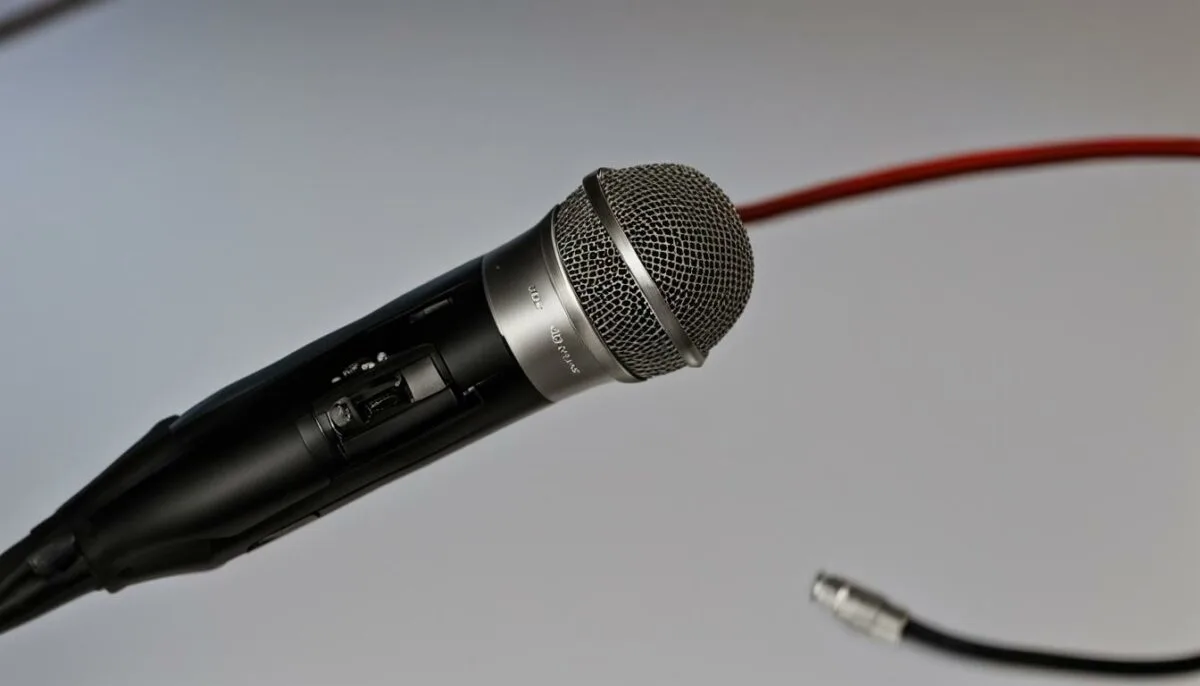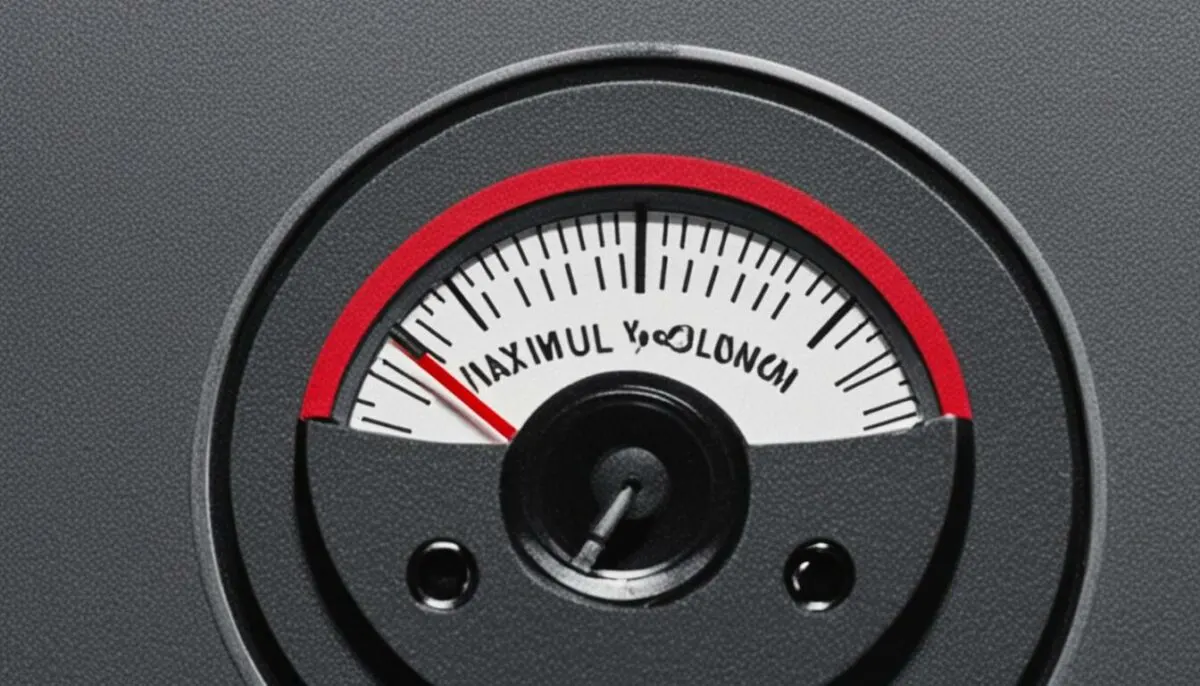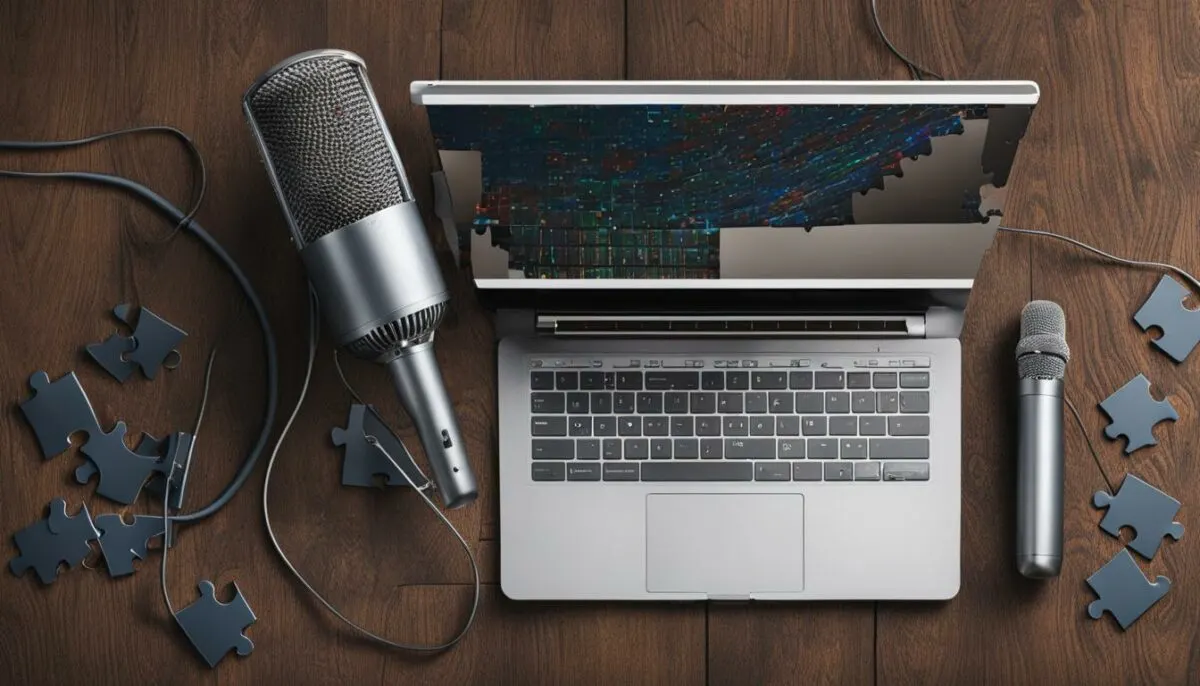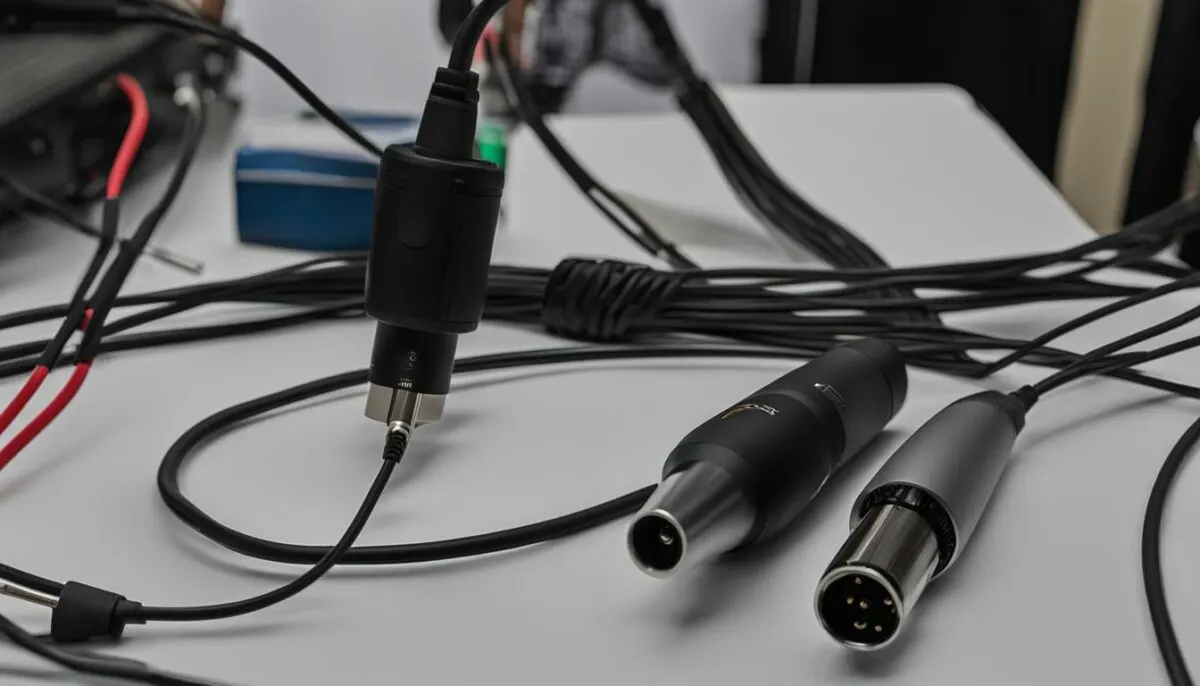Your microphone is an essential tool for hands-free communication and ensuring clear audio for online meetings and other professional purposes. However, it can be frustrating when your mic is too quiet, making it difficult for others to hear you. In this article, we will explore the reasons behind a low mic volume on PCs and provide practical solutions to help you fix the issue at home.
Key Takeaways:
- If your mic is too quiet, it may be due to a low power supply, a faulty or damaged mic, improper mic positioning, or compatibility issues with your PC.
- Check the power supply to your mic and ensure it is receiving optimal power.
- Inspect your mic for any damages or faults that may be affecting its performance.
- Adjust the mic level settings on your Windows PC to increase the mic volume.
- Proper mic positioning, facing your mouth and maintaining an optimal distance, can enhance the mic’s volume.
Reasons for Low Volume in PC Mics
If you’re experiencing low volume issues with your PC mic, there can be several reasons behind it. Understanding these factors can help you troubleshoot the problem and improve your audio experience.
1. Low Power Supply to the Mic
A mic requires a sufficient power supply to function properly. If the power supply is inadequate, it can result in low volume output or the mic not working at all. Check if the power source is delivering enough power to the mic and make sure all connections are secure.
2. Faulty or Damaged Mic
A mic that is faulty or damaged can also cause low volume issues. This can occur if the mic’s diaphragm is broken, the connecting wire is damaged (for corded mics), or the connecting software system is faulty (for cordless mics). Inspect your mic for any visible damage and consider replacing it if necessary.
3. Low Mic Level on Windows
Windows mic settings can sometimes have a default mic volume set lower than optimal levels. This can result in a low mic volume output. Adjusting the mic level settings in your Windows sound settings can help increase the mic volume and improve audio quality.
4. Improper Mic Positioning
The positioning of your mic plays a crucial role in its audio output. If the mic is placed too far from your mouth or not facing you properly, it may result in low volume output. Ensure that the mic is positioned at an optimal distance (around 3 to 6 inches) from your mouth and facing directly towards you.
5. The Mic has Reached its Limit
Some mics have limitations in their volume range or audio output capabilities. If you’re using a mic with low audio volume, it may not be able to produce louder sound. This can often be the case with low-quality mics. Consider upgrading to a higher-quality mic if you frequently encounter low volume issues.
6. Compatibility Issues
Incompatibility between your mic and your PC can also result in low volume output. Ensure that your mic is compatible with your operating system and has the necessary drivers installed. Check the manufacturer’s website for any updated drivers or software patches.
By understanding the reasons behind low mic volume on your PC, you can take the necessary steps to address the issue and improve your audio quality. The next section will provide troubleshooting solutions to help you resolve these problems and achieve optimal mic performance.
Low Power Supply to the Mic

A mic requires an optimal power supply to function properly. If the mic is not getting enough power, it can result in various issues such as the mic not working, low mic volume, or the mic not being loud enough. Insufficient power supply can occur due to problems with the power source or issues with the mic itself.
One common cause of low power supply is using a USB hub that does not provide enough power to the mic. USB hubs with multiple devices connected may not deliver the required power output, leading to low mic performance. Plugging the mic directly into the USB port of your computer can help resolve this issue.
Another factor to consider is the length of the cable connecting your mic to the power source or computer. Longer cables can result in power loss and reduced mic volume. To overcome this, try using a shorter cable or opt for a powered USB extension cable to ensure sufficient power supply to the mic.
If you are using a battery-powered microphone, ensure that the batteries are not running low. Replace the batteries with fresh ones to avoid power-related issues.
A Faulty/Damaged Mic

If you are experiencing low volume output from your mic, it could be due to a faulty or damaged microphone. Various issues can contribute to this problem, including a broken diaphragm, damaged connecting wire (for corded mics), or a faulty connecting software system (for cordless mics).
If your mic’s diaphragm is broken, it may not be able to vibrate properly, resulting in low volume output. This can occur due to physical damage or wear and tear over time. A broken diaphragm requires a repair or replacement to restore the mic’s functionality.
For corded mics, a damaged connecting wire can disrupt the flow of audio signals, leading to low mic volume or no sound at all. Inspect the wire for any visible damage or loose connections. If necessary, consider replacing the wire or seeking professional assistance.
Similarly, if you are using a cordless mic, the connecting software system between the mic and your device may be faulty. Ensure that the wireless connection is secure and functioning properly. If the issue persists, try troubleshooting the connection or contacting the manufacturer for support.
Having a damaged or faulty mic can be frustrating, especially when it hampers your ability to communicate effectively. It’s important to address the issue promptly to avoid any further inconvenience.
To determine if your mic is faulty or damaged, try using it with a different device or computer. If the problem persists, it is likely that the mic itself is the issue. In such cases, consider replacing it with a new microphone to ensure optimal performance and clear audio output.
Low Mic Level on Windows

When using a microphone on a Windows computer, you may encounter the issue of low mic volume. This can lead to your voice being too quiet and not loud enough for others to hear clearly. Fortunately, there are mic volume settings in Windows that can be adjusted to increase the mic volume and improve your audio experience.
In recent versions of Windows, such as Windows 8 and Windows 10, the mic level settings may have a default volume that is lower than optimal levels. This can result in your mic volume being too low and not meeting your needs. To address this issue, you can manually adjust the mic volume settings in Windows.
To adjust the mic volume settings on Windows, follow these simple steps:
- Right-click on the sound icon in the taskbar and select “Open Volume Mixer”.
- Locate the microphone icon and increase the volume level by dragging the slider to the right.
- If you cannot find the microphone icon, click on the small arrow beside the volume controls to access all devices, and adjust the mic volume from there.
Remember to test your mic volume after making these adjustments to ensure it meets your desired level. If necessary, you can further fine-tune the microphone volume in the sound settings of the application you are using, such as communication apps or recording software.
Adjusting the mic volume settings on Windows can help resolve the problem of low mic volume and ensure that your voice is heard clearly during online meetings, voice calls, or any other activities that require the use of a microphone.
Now that we’ve discussed how to tackle low mic volume on Windows, let’s move on to another possible cause of the issue – improper mic positioning.
| Adjusting Mic Volume on Windows | Steps |
|---|---|
| Step 1 | Right-click on the sound icon in the taskbar |
| Step 2 | Select “Open Volume Mixer” |
| Step 3 | Find the microphone icon |
| Step 4 | Increase the volume level by dragging the slider to the right |
| Step 5 | If the microphone icon is not visible, click on the small arrow beside the volume controls |
Improper Mic Positioning

The positioning of your mic is a key factor in its audio output. If your mic is not loud enough or the volume is low, it could be due to improper mic positioning. Placing the mic too far from your mouth or not facing it properly can result in low volume output and the mic not picking up sound effectively.
To improve the mic volume and ensure optimal performance, follow these positioning tips:
- Distance from the mouth: Maintain an optimal distance of 3 to 6 inches between the mic and your mouth. This allows the mic to capture your voice clearly and prevents the volume from being too low.
- Proper orientation: Ensure that the front side of the mic, usually indicated by a logo or markings, is facing your mouth directly. This helps the mic accurately capture your voice and avoids any interference that may result in low volume.
By positioning your mic correctly, you can improve its volume and ensure that it picks up sound effectively. Experiment with different mic positions and orientations to find the best setup that suits your needs.
Note: The right positioning may vary depending on the type of mic you are using (such as a headset mic or a standalone microphone). Refer to the manufacturer’s guidelines for specific instructions on positioning and placement.
The Mic has Already Reached its Limit

Some mics have limitations in their volume range or audio output capabilities. If you are using a mic with low audio volume, your voice may not reach others effectively through your PC. This is often encountered with low-quality mics.
| Issue | Possible Cause | Solution |
|---|---|---|
| Mic volume low | Low-quality mic with limited volume capabilities | Upgrade to a higher-quality mic with better volume range |
| Mic not loud enough | Mic reaching its maximum volume output | Consider using a different mic that offers higher volume levels |
| Mic not picking up sound | Mic sensitivity too low to capture sound effectively | Replace the mic with one that has better sensitivity and audio pickup |
The Mic is not Compatible

Mics come in different ranges and with different functions and volume levels. Not all mics are compatible with every PC. It is possible that your mic hardware or software is not compatible with your PC, resulting in low volume or inadequate sound output.
If you are experiencing mic compatibility issues, it can be frustrating, but there are steps you can take to address the problem. First, check if the mic you are using is designed for your specific operating system. Some mics are only compatible with Windows, while others work best with macOS or Linux.
Additionally, ensure that your mic is compatible with the input/output jacks on your computer. Some mics require specific connections, such as USB or XLR, while others may use a standard 3.5mm audio jack. Refer to the mic’s user manual or the manufacturer’s website for information on compatibility with different devices.
If you are using an external USB microphone, try connecting it to a different USB port on your computer. Sometimes, mic compatibility issues can arise due to driver conflicts or power supply problems from specific USB ports.
Another common compatibility issue is with the software you are using to record or communicate. Make sure that the application or software you are using supports the mic you have. Check the software’s documentation or support resources for information on mic compatibility.
If you have checked all the compatibility factors and your mic still isn’t working properly, it may be time to consider investing in a new mic that is specifically designed to work with your PC. Look for mics that have been tested and recommended for your operating system, and check user reviews to ensure compatibility and performance.
| Mic Compatibility Checklist |
|---|
| Check if the mic is compatible with your operating system |
| Ensure compatibility with the input/output jacks on your computer |
| Try connecting the mic to a different USB port |
| Verify compatibility with the software or application you are using |
| Consider investing in a new mic designed for your PC |
By addressing mic compatibility issues, you can improve the sound quality and volume of your microphone, ensuring clear and crisp audio for all your communication needs.
Check for Loose Connections

One of the common reasons for a mic not working or having low volume is a loose connection. It’s essential to check the connections of your mic, especially for corded mics, to ensure they are properly connected to your PC or power source. For cordless mics, it’s important to verify the connection settings.
“A loose mic connection can result in mic volume issues. Ensuring a secure and stable connection is vital for optimal audio performance.”
If you’re using a corded mic, make sure the cable is firmly plugged into both the mic and your computer. Reconnecting or reinserting the USB power cable, if applicable, can help resolve any loose connection issues. For cordless mics, ensure that the Bluetooth connection is active and properly paired with your device.
Here’s a step-by-step guide to checking and fixing loose connections for both corded and cordless mics:
- For Corded Mics:
- Check the cable connection from the mic to your PC.
- If the connection seems loose, unplug and reinsert the cable firmly.
- Make sure the cable is securely plugged into your computer’s audio input/output port.
- Test the mic to see if the volume issue is resolved.
- For Cordless Mics:
- Ensure that the Bluetooth connection is active on your PC.
- Check if the mic is properly paired with your computer.
- If the pairing seems weak or disrupted, reconnect the Bluetooth mic following the manufacturer’s instructions.
- Verify that the Bluetooth settings on your PC recognize the mic as a connected device.
- Test the mic to see if the volume issue is resolved.
Checking for loose connections and making the necessary adjustments or reconnections can often resolve mic volume issues. However, if the problem persists, other troubleshooting steps may be required.
Example Table:
| Issue | Solution |
|---|---|
| The corded mic cable is loose | Reconnect the cable securely |
| The cordless mic is not paired correctly | Reconnect the Bluetooth mic following the manufacturer’s instructions |
Image related to “Check for Loose Connections” section:
Check the Master Volume
If you’re facing issues with low mic volume, adjusting the master volume settings on your PC can help solve the problem. By increasing the master volume, you can boost the mic volume and ensure clearer audio. There are two ways you can adjust the master volume:
- Through the sound icon on your toolbar:
- Locate the sound icon on your toolbar, usually represented by a speaker symbol.
- Click on the icon to open the volume control options.
- Drag the master volume slider to the right to increase the volume.
- Open the application you are using (e.g., Zoom, Skype, Microsoft Teams).
- Navigate to the audio settings within the app.
- Adjust the master volume settings to increase the mic volume.
Please note that the specific steps for adjusting the master volume might differ based on your Windows version. Refer to the Windows support documentation or the application’s user guide for detailed instructions.
“Increasing the master volume can significantly improve the overall sound quality and boost the volume of your microphone. Don’t forget to also consider adjusting the mic volume within the application you are using for communication.” – Audio Pro Tips
Update the Sound Card Drivers
If your mic volume is still low after trying the previous solutions, it may be time to update your sound card drivers. Outdated or incompatible drivers can cause issues with mic volume and overall audio performance. Updating the sound card drivers ensures that your mic is functioning optimally and can deliver the desired volume.
To update the sound card drivers, follow these steps:
- Open the Control Panel on your Windows or Mac device.
- Navigate to the “Device Manager” or “Hardware and Sound” section.
- Expand the “Sound, video, and game controllers” category to view all the installed audio devices.
- Right-click on your sound card or audio device and select “Update driver” or “Update driver software”.
- Choose the option to search automatically for updated driver software. Windows or Mac will then search for the latest drivers and install them.
- Restart your computer to apply the driver updates.
Updating the sound card drivers can resolve any compatibility issues and provide a boost to your mic volume. It ensures that your mic receives the necessary resources and settings to produce louder and clearer audio. Remember to check the manufacturer’s website for the latest drivers specific to your sound card model if the automatic update does not find any new drivers.
Mic Volume Troubleshooting Tip:
If updating the sound card drivers doesn’t resolve the low mic volume issue, you can also try uninstalling the current sound card drivers completely and then reinstalling them from scratch. This process can sometimes fix driver conflicts or errors that may be impacting the mic volume.
| Common Sound Card Brands | Website |
|---|---|
| Realtek | https://www.realtek.com |
| Creative | https://us.creative.com |
| ASUS | https://www.asus.com |
Try Using a Sound Booster or Replace the Mic
If you have been experiencing consistently low mic volume, there are a couple of solutions you can try. One option is to use a sound booster device, which can enhance the audio output and increase the mic volume. These devices work by amplifying the signal from your mic, allowing for clearer and louder audio.
Another solution is to replace the mic altogether. If your mic is incompatible with your PC or has been damaged beyond repair, a new mic can help solve the low volume issue. When selecting a new mic, make sure to choose one that is compatible with your computer and meets your specific requirements in terms of audio quality and sensitivity.
By either using a sound booster or replacing your mic, you can overcome the challenge of low mic volume and ensure that your voice is heard loud and clear in your online meetings, podcasts, or other audio recordings. Remember to test your mic after implementing these solutions to ensure optimal performance.
FAQ
Why is my mic so quiet?
There are several potential reasons why your mic volume may be low on your PC. These include low power supply to the mic, a faulty or damaged mic, low mic level on Windows, improper mic positioning, the mic reaching its limit, or compatibility issues between the mic and your PC.
How can I fix a low mic volume on my computer?
To fix a low mic volume, you can try adjusting the mic level settings in Windows, ensuring proper mic positioning, checking for loose connections, adjusting the master volume settings, updating the sound card drivers, or using a sound booster device. Alternatively, if your mic is faulty or incompatible, replacing it with a new mic may solve the issue.
What can cause a low power supply to the mic?
A low power supply to the mic can be caused by issues with the power source or the mic itself. It may not be receiving enough power to function properly, resulting in low volume output or no sound at all.
How can I determine if my mic is faulty or damaged?
If your mic is faulty or damaged, it may not work properly and produce low volume output. You can check for signs such as a broken diaphragm, damaged connecting wires (for corded mics), or a faulty connecting software system (for cordless mics).
How can I adjust the mic level on Windows?
Adjusting the mic level on Windows can help increase the mic volume. You can do this by going to the sound settings in the control panel or the sound icon on your taskbar, and increasing the mic level to a suitable volume.
How does improper mic positioning affect volume?
Improper mic positioning, such as placing the mic too far from your mouth or not facing it properly, can result in low volume output. Maintaining an optimal distance of 3 to 6 inches between the mic and your mouth and ensuring it is facing your mouth can improve the mic’s volume.
What does it mean when the mic reaches its limit?
Some mics have limitations in their volume range or audio output capabilities. If you are using a mic with low audio volume, your voice may not reach others effectively through your PC, as the mic may already be at its maximum output level.
Can mic compatibility affect volume?
Yes, mic compatibility is important for proper volume and sound output. Not all mics are compatible with every PC. If your mic hardware or software is not compatible with your PC, it may result in low volume or inadequate sound output.
How do loose connections affect mic volume?
Loose connections can cause mic volume issues. It is important to check the connections of your mic, especially for corded mics, ensuring they are properly connected to your PC or power source. For cordless mics, check the connection settings and reconnect or reinsert the USB power cable or Bluetooth connection if necessary.
How can adjusting the master volume settings help?
Adjusting the master volume settings on your PC can boost the mic volume. You can increase the master volume through the sound icon on your taskbar or adjust the master volume settings in the communication app you are using.
How can I update the sound card drivers?
Outdated or incompatible sound card drivers can cause mic volume issues. You can check the status of your sound card drivers in the control panel and update them if necessary. This applies to both Windows and Mac devices.
How can a sound booster or mic replacement help?
If your mic volume is consistently low, you may consider using a sound booster device to enhance the audio output and increase the mic volume. Alternatively, if your mic is incompatible or damaged beyond repair, replacing it with a new mic can help solve the low volume issue.